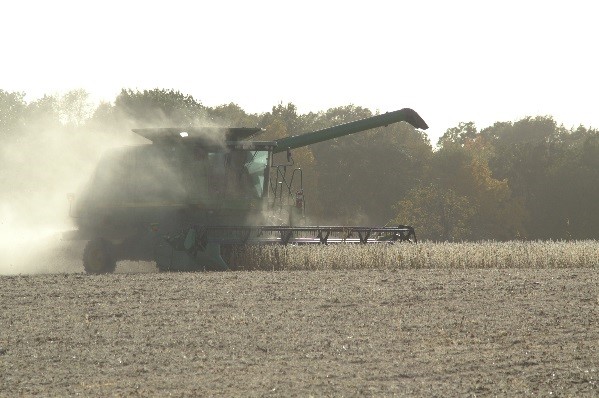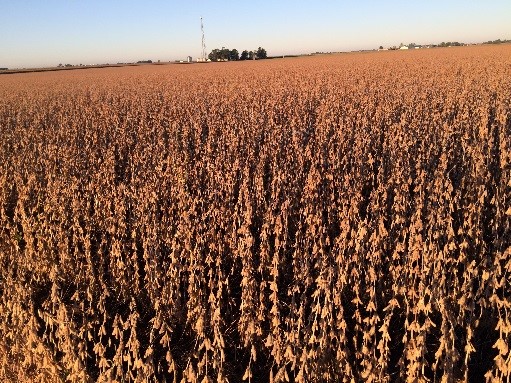Assessing soybean maturity and predicting harvest strategies for harvesting most acres at 13.5 to 14 percent moisture.
Beans bouncing off the windshield are just one indication that you may be losing bushels by harvesting below the optimum moisture content of the grain.
All throughout the challenging 2017 growing season, this year’s other CCA Soy Envoys and I have been suggesting ways to increase profitability of your soybean crop. Variety selection, early planting, weed management and control, disease management, insect pest management—these have been topics covered by the 2017 Soy Envoy blogs. As the growing season wraps up and harvest approaches, there are still several ways to maintain the yields and profitability that you have managed for all year.
 Unlike corn, soybeans’ maturity is relatively difficult to predict. It seems like it should be straightforward. As Soy Envoy Stephanie Porter stated in her August blog, the main factor in soybean maturity is the photoperiod, or day length. It would seem, then, that it would be simple to follow the calendar and say, “On this date, the beans will be ready to harvest.”
Unlike corn, soybeans’ maturity is relatively difficult to predict. It seems like it should be straightforward. As Soy Envoy Stephanie Porter stated in her August blog, the main factor in soybean maturity is the photoperiod, or day length. It would seem, then, that it would be simple to follow the calendar and say, “On this date, the beans will be ready to harvest.”
We all know it’s not that simple. When the soybean reaches physiological maturity, R8 in our system of growth staging, the beans contain about 35 percent moisture. Beans then have to dry down to the standard marketplace moisture of 13 percent. There are many variables involved in reducing the moisture. Weather conditions such as temperature, humidity and wind, and pest and disease pressure, soil types, size of the bean plants themselves, and more—all play a part in determining how long it will take to move from maturity to harvest. And no field or, for that matter, plant is ever uniform in this process. Variability in maturity is the name of this game.
The standard bushel of yellow soybeans is 60 pounds at 13 percent moisture. If harvested at 9 percent moisture, growers sacrifice 4.4 percent of the bushels compared to harvesting at the optimum 13 percent. With commodity prices at current levels, who can take that hit to their bottom line? But what can be done to harvest as much of the crop at or near optimum moisture?
 In my research efforts for this article, a variety of publications noted that starting harvest earlier is one strategy that might work toward harvesting a larger percentage of your soybeans at or near 13 percent. Take a scouting run to your early maturing fields, get out of the truck and take samples. You may find that fields are drier than they appear from a windshield survey. The moisture discount at your local elevator for soybeans slightly wetter than optimum may be less than the loss if you harvest those soybeans at 9 to 11 percent. Starting a day or two earlier than you normally would may allow you to capture some of those lost bushels.
In my research efforts for this article, a variety of publications noted that starting harvest earlier is one strategy that might work toward harvesting a larger percentage of your soybeans at or near 13 percent. Take a scouting run to your early maturing fields, get out of the truck and take samples. You may find that fields are drier than they appear from a windshield survey. The moisture discount at your local elevator for soybeans slightly wetter than optimum may be less than the loss if you harvest those soybeans at 9 to 11 percent. Starting a day or two earlier than you normally would may allow you to capture some of those lost bushels.
In my April blog, I talked about choosing to seed as much as one full maturity group later than you normally would if planting early. Reality is, planting several different maturities will help you to move toward harvesting more of your crop at the optimum moisture level. There can be relatively little difference between harvest dates in varieties whose maturity differs by only 0.3 to 0.5. I once had a grower ask me in a meeting what the difference in maturity was between a 2.5 and a 2.8 soybean. His neighbor piped up, “About half an hour!”
When you are buying seed, you may want to look at getting some soybeans that push some of your acres to later-maturing beans than you are accustomed. If you are in my area of Northern Illinois and are used to planting no later than 2.8 to 2.9, think about a few acres that get a 3.3 to 3.4 maturity soybean. I know many are worried about frost—it’s hard not to be somewhat concerned in 2017 with all the recent cool weather in August. But in most years, there is plenty of leeway on planting some soybeans that are later. With the ease of switching combine headers and settings to harvest different crops all in one day, it’s not nearly as serious to change from beans to corn and back again if it makes sense.
In managing soybeans for more profitability, harvesting as close to 13 percent moisture as possible is one way to maximize your yield without a great deal of extra effort or cost.


 and then
and then